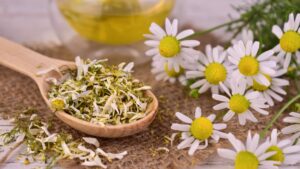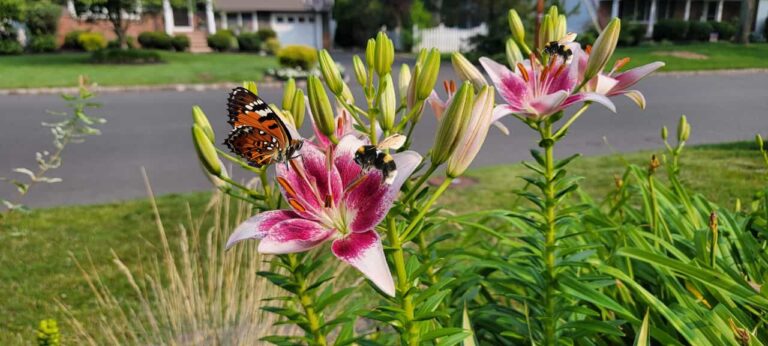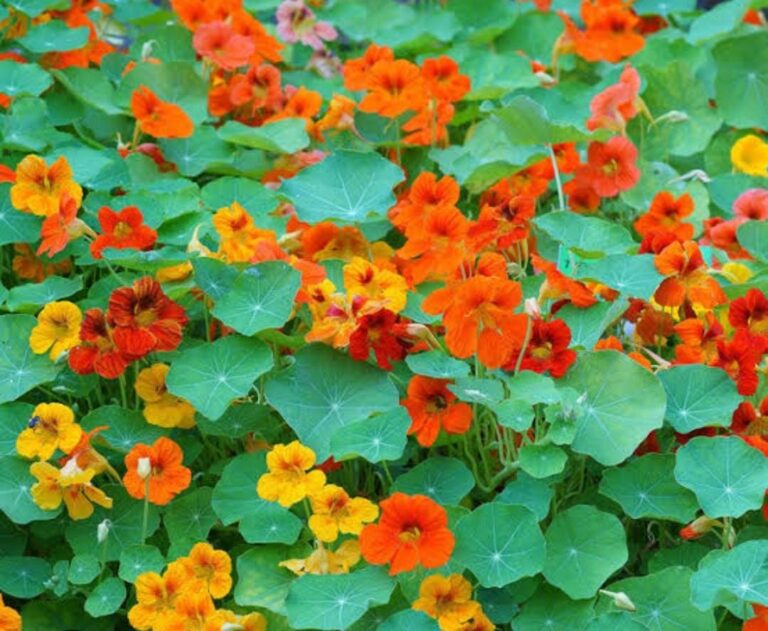Chamomile: 4 Magnificent Uses
Introduction
One of the most popular medicinal plants, chamomile is prized for its relaxing properties and wide range of health advantages. This common herb has been used for millennia in many different civilizations, and it has captivated pharmacologists, botanists, and holistic practitioners. This thorough investigation will reveal the pharmacological qualities, botanical traits, and scientific significance of chamomile.
Botanical Classification and Morphology
Chamomile is a member of the Asteraceae family, which also contains sunflowers and daisies. In medicine, two main species are frequently utilized:

- German chamomile, or Matricaria chamomilla: German chamomile is an annual plant with tiny white flowers encircling a brilliant yellow conical core and finely split leaves. It spreads widely throughout Asia and Europe
- Roman chamomile, or Chamaemelum nobile: The perennial Roman chamomile plant has a creeping growth habit and yields somewhat larger but comparable blooms with a unique scent reminiscent of apples.
Cultivation and Growth Requirements
Sandy soils that drain well and have a moderate moisture content is ideal for its growth. It can withstand some shade but prefers full sun. 59–77°F is the optimal temperature range for germination. Roman chamomile spreads by rhizomes, which makes it better suited for perpetual cultivation than German chamomile, which self-seeds widely.
The composition of phytochemicals
The therapeutic benefits of this flower are attributed to its abundance of bioactive components. Among the essential components are:

- Flavonoids, including luteolin, quercetin, and apigenin, are remarkable compounds celebrated for their powerful antioxidant and anti-inflammatory effects. These natural wonders help protect our cells from damage but also play a crucial role in supporting overall health. You should discover the incredible benefits these vibrant plant pigments can bring to your well-being!
- Terpenoids, including chamazulene and bisabolol, are fascinating compounds known for their remarkable antibacterial and anti-inflammatory properties. This fights off harmful bacteria and helps soothe inflammation, making them valuable allies in promoting better health and well-being.
- Coumarins are fascinating compounds known for their remarkable cardiovascular benefits and effective blood-thinning abilities. These natural ingredients can play a crucial role in promoting heart health and improving circulation.
- Phenolic acids bring an extra boost of antioxidant power, enhancing our health in delightful ways!
The compound that gives it essential oil its distinctive blue color, chamazulene, is especially prized for its strong anti-inflammatory properties.
Chamomile as a Pollinator Plant
Chamomile is more than just a soothing tea; it’s a valuable ally for supporting pollinator populations. Its composite flower structure is adorned with small florets that produce abundant nectar and pollen, attracting bees, butterflies, and hoverflies with its bright yellow disc and delightful aroma.
With a blooming period from late spring to early autumn, it provides a consistent food source for pollinators, ensuring their vitality. Research indicates that chamomile pollen is rich in essential nutrients, boosting pollinator activity and enhancing crop pollination in backyard gardens as well as agricultural systems. I must say this plant is a good addition to your companion planting.
Additionally, it has natural pest-repelling properties, fostering a balanced ecosystem where beneficial insects thrive. By incorporating chamomile into your garden, you’re beautifying your backyard garden while actively contributing to pollinator conservation and enjoying its medicinal benefits. It’s a win-win for you and the environment!
Traditional and Modern Uses
The use of this beauty in traditional medicine is not new. In the beginning, ancient Greeks, Romans, and Egyptians used it to cure everything from wounds to stomach issues. As a common tea or topical application, chamomile remains a mainstay of herbal medicine in contemporary times.
1. Sleep and Relaxation

Apigenin is a specific type of flavonoid found in various plants, including chamomile, that plays a significant role in promoting relaxation and alleviating anxiety. This compound interacts with GABA (gamma-aminobutyric acid) receptors in the brain, which are crucial in helping to regulate mood and induce a sense of calm. Research indicates that the calming effects of its tea can be attributed largely to apigenin, making it a popular natural remedy for stress relief.
Moreover, studies have shown that individuals suffering from insomnia may benefit from incorporating this tea into their night routine. Regular consumption of this herbal beverage has been linked to improved sleep quality, as it not only helps in reducing anxiety but also may allow for a more restful and uninterrupted night’s sleep. Therefore, chamomile tea is a gentle yet effective option for those seeking natural methods to support better sleep patterns.
2. Digestive Health
Chamomile is a well-known herb celebrated for its calming effects and has been used for centuries to relieve gastrointestinal discomfort. Its soothing properties make it effective for issues like indigestion, nausea, and bloating.

It is particularly valued for its antispasmodic abilities, which help relax the muscles of the gastrointestinal tract, relieving cramps and spasms. Research suggests it may also benefit those with irritable bowel syndrome (IBS), alleviating chronic abdominal pain and bloating. Whether enjoyed as tea or in herbal remedies, it offers valuable support for digestive health and overall well-being.
3. Anti-Inflammatory and Pain Relief
Chamomile is a remarkable herb celebrated for its powerful anti-inflammatory benefits, making it an excellent ally for anyone dealing with discomfort. Whether you’re battling menstrual cramps, muscle soreness, or the nagging symptoms of arthritis, chamomile has your back.
The magic lies in its key compounds, bisabolol and chamazulene. Bisabolol isn’t just a fancy name; it acts as a healing agent, reducing swelling and promoting recovery in the body. Meanwhile, chamazulene steps in with its strong anti-inflammatory properties, soothing irritation and nurturing your overall wellness. These dynamic ingredients make this flower a go-to natural remedy for pain and inflammation.
4. Skin and Wound Healing
Chamomile extracts have become a beloved staple in skincare, and for good reason! Derived from the delicate flowers, these extracts are celebrated for their remarkable soothing and antibacterial qualities. If you’ve ever struggled with irritated skin or inflammation, you’ll appreciate how chamomile works wonders to calm and nurture your complexion.

But that’s not all—research has unveiled that it also plays a crucial role in stimulating collagen production and boosting fibroblast activity. Why is this important? Because collagen is the superhero protein our skin relies on for structure and repair, especially when healing minor cuts and irritations.
By incorporating chamomile extracts into your skincare routine, you’re not just pampering your skin; you’re actively contributing to its health and resilience. With these magical properties, it’s no wonder that chamomile is a sought-after ingredient in countless beauty and healing products. Treat your skin to the nurturing benefits of chamomile, and watch as it flourishes!
Scientific Research and Clinical Studies
Numerous scientific investigations have confirmed the therapeutic benefits of chamomile. Among the important conclusions are:
- Benefits for Anxiety and Sleep: A study that was published in Phytomedicine showed that chamomile extract considerably lessened generalized anxiety disorder (GAD) symptoms
- Gastrointestinal Relief: By calming smooth muscle contractions, chamomile has been demonstrated in clinical research to lessen acid reflux and improve digestion
- Anti-Cancer Potential: According to recent studies, the flavonoids in chamomile may cause some cancer cells to undergo apoptosis or programmed cell death
Safety and Considerations
Chamomile has long been celebrated for its soothing properties, making it a favorite among herbal enthusiasts. However, before you brew that calming cup, it’s important to keep a few precautions in mind. If you have allergies to plants in the Asteraceae family—like ragweed, marigolds, or daisies—you might want to steer clear of chamomile, as it could trigger allergic reactions. Be on the lookout for symptoms such as skin rashes, respiratory issues, or stomach discomfort.
Moreover, if you’re taking anticoagulant medications to prevent blood clots, it’s crucial to chat with your healthcare provider before adding chamomile to your regimen. The herb can interact with these medications, potentially increasing the risk of bleeding. So, while it can be a delightful addition to your wellness routine, a little caution goes a long way to ensure a safe and enjoyable experience!
Conclusion
Chamomile is a true treasure among medicinal herbs, celebrated for its diverse and powerful benefits. With a wealth of scientific backing, it has earned its place in conventional and alternative medicine, making it a cornerstone of natural health remedies. Whether you’re enjoying a calming cup of chamomile tea, indulging in the soothing embrace of aromatherapy, or using its topical applications, this remarkable herb is a wonderful ally for your overall wellness. Embrace the magic of chamomile and elevate your self-care routine!







